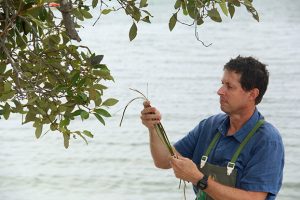A new Griffith-led study has developed a framework to operationalise global ‘theories of change’, coordinating local and global actions to secure a future where humans live in harmony with nature.
Published in Nature Sustainability, the research translates global-scale theories of change, into tangible steps for conservation of ecosystems. These steps take account of the economic and political conditions in each nation to ensure conservation actions have the best chance of working.

“How can we ensure habitats like dense seagrass meadows will continue to thrive and support sustainable fisheries into the future?” asked lead author Dr Christina Buelow, a Research Fellow at the Australian Rivers Institute.
Global theories of change provide broad, overarching guidance for the conservation and sustainable use of Earth’s ecosystems, but they don’t inform how conservation actions will lead to benefits for society and ecosystems. A robust theory of change must consider the social, economic and political factors that allow actions to be successfully implemented – known as ‘enabling conditions’.
“National policy is unlikely to lead to successful outcomes if governance is ineffective,” Dr Buelow said.
“Earlier this year for example, the Kunming-Montreal Global Biodiversity Framework (KM-GBF) was adopted to support just and sustainable use of the Earth’s ecosystems, the overall goal being to secure by 2050 a future where humans live in harmony with nature.
“However, the framework to translate global commitments to local context is unclear,” Dr Buelow said.
In their research, Christina and colleagues outline a three-step framework for applying global theories of change like the KM-GBF.

Enabling profiles that classify nations according to their social, economic and political capacity for sustainably managing and conserving ecosystems underpins the three-step conservation pathway.
“In our research we show what types of conservation approaches for coastal ‘blue carbon’ ecosystems (seagrass, mangroves, and saltmarsh) are best in different nations,” explains Associate Professor Christopher Brown, senior co-author of the study from the University of Tasmania.
“Our research informs theories of change for conserving these ecosystems that punch above their weight in providing carbon storage, fisheries and other benefits to humans.
“For countries with high internal capacity to enable conservation, we described theories of change and corresponding actions that strengthen policy and regulation, whilst alternatively, those with low internal enabling capacity, have a bigger requirement for formalising community-led conservation.”

Professor Rod Connolly, Director of the Global Wetlands Project, points out that “the interactive web app can be used to explore national blue carbon status and ultimately generate regional enabling profiles to inform localised theories of change that underpin National Biodiversity and Strategy Action Plans.”
Coordinating actions across nations will be key to achieving conservation and biodiversity targets like that set out in the Kunming-Montreal Global Biodiversity Framework and the Sustainable Development Goals.
“The framework we have developed can be applied to other ecosystems to help to coordinate actions, and ensure they are effective for the specific socioeconomic and political conditions,” Dr Buelow said.
“Tools like our three-step framework are needed to synergise our efforts to achieve common goals, such as sustainable fisheries supported by healthy seagrass habitat, by the year 2050 and beyond.”




